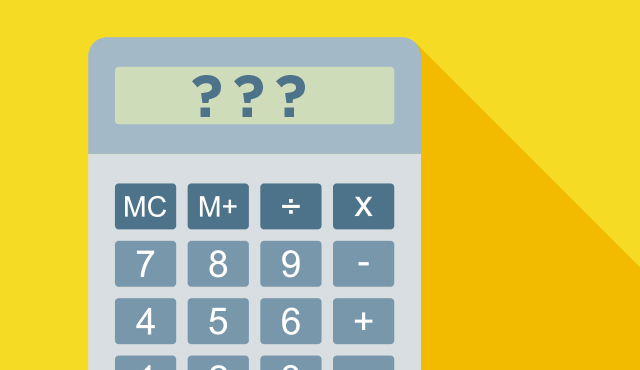
Ah, calculators. How we depend on them.
It is worth remembering that the GMAT Quantitative section doesn’t assess your ability to perform time-consuming calculations so much as your ability to do calculations in smart, time-efficient ways. If you can learn the difference, you can save yourself significant time—and improve your GMAT Quantitative score.
Here are seven principles to help you achieve the (intimidating but extremely attainable) goal of Quantitative success without a calculator:
Principle #1: Data Sufficiency is more about reasoning than calculation
How many times have you gotten stuck perfectly working out a time-consuming calculation on Data Sufficiency, only to find that you selected a trap answer and got the question wrong? Take a look at this sample question.
What is the value of x ?
- 3 < x < 5
- x3 is equivalent to the reciprocal of the square root of 10-3
Statement 1 looks very friendly, doesn’t it? But be careful when evaluating Statement 1: that’s actual an inequality which represents a range of values between 3 and 5. Since nothing in the problem states that x is an integer, x can take on values other than 4. Hence, this statement is actually insufficient.
Let’s be honest, Statement 2 looks terrifying with no calculator available! But before you groan and try to figure out the square root of 10-3 by hand, think! The job is not to pinpoint the value of x, but to state whether it can be pinned down. First, consider x3. When a variable is raised to an odd exponent, there is one solution (unlike even exponents, which produce two solutions). Furthermore, the statement contains the phrase “is equivalent to,” followed by an actual value (albeit a strange one), which means that there is one actual value for x. Your job is finished. Statement 2 alone is sufficient; no calculation is required.
Principle #2: Fractions are your friends
Fractions and decimals are just different ways of communicating the same value, right? So why does it matter whether you use 1/4 or 0.25 in a problem? The truth is, when you’re forced to calculate by hand, you’re often better off using fractions than potentially struggling with decimals. That’s particularly true on the GMAT, where the numbers selected for the problems are often chosen because they are fraction-friendly.
Let’s say that you’re a GMAT question writer and that you want to test whether the test-taker knows how to work with percentages. You are considering two versions of the following problem. Which do you choose to put on test?
At the beginning of the week, Fred’s treat jar contained 32 dog biscuits. If Fred ate 12.5% of the dog biscuits on Monday, how many dog biscuits are left on Tuesday?
or
At the beginning of the week, Fred’s treat jar contained 35 dog biscuits. If Fred ate 14% of the dog biscuits on Monday, approximately how many dog biscuits are left on Tuesday?
If you said that the first problem is the more likely to be chosen, you’re right. In fact, the numbers for this problem would have been carefully selected precisely because they are fraction-friendly. Note that 12.5% = 1/8 and that 1/8 x 32 = 4, so there are 28 biscuits left for Fred to enjoy. Using fractions is faster than doing the calculation as 0.125 x 32 because you get to cancel when using fractions. The GMAT test-writers, by the way, would be happy to give you credit for the problem if you solved using decimals because they know that it most likely took you longer.
As for the second version of the problem, there’s no nicer way to work with the numbers. You just need to grind through it. So, this version tests calculation skills rather than reasoning skills, and the GMAT is far more interested in your reasoning skills.
So, get comfy using fractions to solve GMAT problems!
Principle #3: Depend on the Distributive Law
Of course, occasionally you may need to work with decimals. Suppose you needed to multiply 5 by 0.17. While that might initially give you pause, know that there’s a faster way to multiply if the numbers go beyond the times tables—which, nota bene, you should definitely memorize up to 15 times 15. Math is based on units of ten, so find ways to use powers of 10 with the Distributive Law. To calculate 5(0.17), first drop the decimal point (you can put it back in later). Then 5 x 17 becomes 5(10 + 7) which is 5(10) + 5(7). For this problem, you’ve simply got to add 50 and 35 to get 85. Now return the decimal point, and you get the answer: 0.85.
This handy trick can be used to tackle all sorts of calculations. Take this one: What is 13% of 199? First, look for multiples of 10: It happens that 199 is equal to 200 – 1. Therefore, this problem can be written as 0.13(200 – 1) = 0.13(200) – 0.13(1). Since 13% of 100 is 13, it follows that 13% of 200 is twice as much, or 26. Thus, this calculation simplifies to 26 – 0.13, or 25.87.
Using the Distributive Law is a key part of working with numbers in smart, efficient ways and that’s the sort of reasoning that the GMAT seeks to test.
Principle #4: Rely on your real-world skills
All of us have to do some mental calculations in day-to-day life. Estimating remaining fuel, approximating arrival times, or adjusting a recipe all involve “data analysis” skills, i.e., averages, rates, percentages, and ratios. Do you take 10% of your bill and multiply by 2 to figure out a tip?
Don’t be intimidated by a problem just because it’s on the GMAT. The skills you’re being tested on are skills that you use all the time. You just need to apply those skills to GMAT problems just like you do when confronted with real world problems. Many percentages on the GMAT can be treated as if they were tips (albeit occasionally large ones): 60% is just 6 x 10%, while 35% is just 3 x 10% plus one-half of 10%. Any trick you use to get by in life can be used to conquer the GMAT!
Principle #5: Reduce early, reduce often
Have you ever multiplied two unwieldy fractions, only to have to reduce the resulting (very large) numerator and denominator? Not only is the initial multiplication more time-consuming than it needs to be, but having to reduce large numbers also invites an opportunity for error. Should you find yourself in that situation on the GMAT (or on a practice GMAT), find ways to reduce ahead of time.
Here’s an example: What is (1/7) + (1/12) divided by (1/7)(1/12)? To add 1/7 and 1/12 in the numerator, you will have to multiply 7 times 12 to get a common denominator. But wait, in the denominator, you will also have to multiply 7 times 12. Therefore, don’t multiply 7 times 12 in either the numerator or denominator, but instead just leave it expressed as (7)(12). Adding the fractions in the numerator gives you 12 + 7 over (7)(12), or 19/(7)(12). Multiplying the fractions in the denominator gives you 1/(7)(12). Now the last step is to divide the numerator by the denominator. Since dividing fractions entails simply flipping and multiplying, we get 19/(7)(12) times (7)(12)/1. The quantity of (7)(12) will cancel entirely, and the result is just 19/1, or 19.
Here’s another way to think of this skill: Resist the urge to multiply until absolutely necessary! That usually means don’t multiply until you’ve reduced!
Principle #6: Need to divide? Look for shared prime factors!
This principle is the corollary of the reduce early, reduce often principle. It also goes hand in hand with the idea that the GMAT chooses the numbers in a problem with great care.
Suppose that as one step of a problem, you needed to divide 2,205 by 105. That looks like it could take forever, right? But, the GMAT generally chooses numbers for problems that work out nicely. All you need to do to verify that assertion is flip through the GMAT Official Guide. You’ll see that there are a lot more answers that look like 14 (an integer) than 32.72.
Here’s the important rule to know: If integer a is divisible by integer b, it means that the prime factors of integer b are a subset of the prime factors of integer a. In other words, 60 is divisible by 12 because the prime factorization of 60 is 2 x 2 x 3 x 5 and the prime factorization of 12 is 2 x 2 x 3. So, the prime factors of 12 are a subset of the prime factors of 60, and that means that 60 is divisible by 12.
So, back to dividing 2,205 by 105. The prime factorization of 2,205 is 3 x 3 x 5 x 7 x 7 and the prime factorization of 105 is 3 x 5 x 7. Now, just cancel out the shared prime factors. You’re left with 3 x 7 = 21. So, 2,205/105 = 21.
Principle #7: Let the answers be your guide
On Problem Solving questions, the format of the answer choices can guide your approach. A student could spend several minutes calculating the cube root of 4 by hand before noticing that the answer choices were expressed in ranges (less than 0, between 0 and 1, between 1 and 2, etc.). In such instances, you’re supposed to estimate, not calculate.
Don’t be the test-taker who laboriously multiplies out the answers to a question about exponents, only to discover that the answer itself was expressed in exponential form. In that case, the problem was testing the test-taker’s ability to use exponential rules to rewrite the answer—not to calculate it. Suppose, for instance, that the GMAT asks this:
Which of the following is equivalent to 2354 ?
- 5(73)
- 2(103)
- 2(104)
- 5(103)
- 5(104)
In this case, the exponential form of the answer choices indicates that you are not supposed to calculate the answer by multiplying 8 x 625 to get 5,000. Instead, you’re meant to see that 2s and 5s can be grouped into 10s. In this case, the original expression can be written as 23535, which is 103(5), which is the same as choice D: 5(103).
The Takeaway
Simplify first, distribute whenever possible, and let the answers guide your approach. Trust your “real-world math” by finding a way to relate GMAT Quantitative questions to familiar scenarios. Most importantly, liberate yourself from the calculator in your daily life. Memorize your times tables, practice your decimal-to-fraction conversions, and add and subtract by hand when required. If you make everyday math a part of your everyday life, you’ll gain the needed confidence to score like the GMAT masters!
Read More

Find MBA Programs Matched to Your Interests
Explore our featured business schools to find those that are looking for students like you.

Top Online MBA Programs
On a mission to increase your salary? Our Top 50 Online MBA ranking is based on academics, career outcomes, tech platforms, and more.

Best Career Prospects
Find out which schools have the best track records for getting students jobs—and the highest starting salaries.

Top Schools for Entrepreneurship
Ready to build your own business from the ground up? Check out these 50 graduate programs.